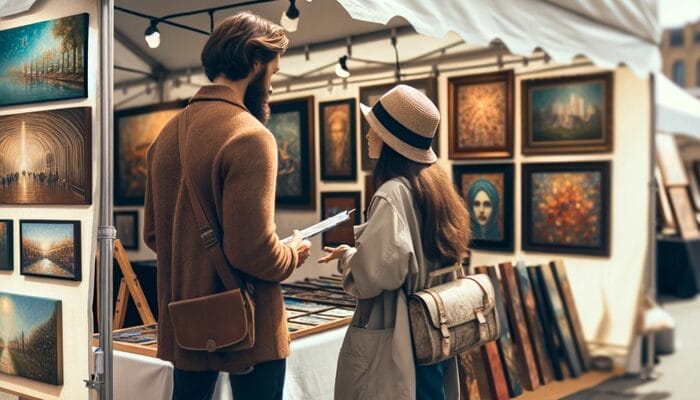An artistic vision statement is a concise and powerful declaration that captures the essence of an artist’s beliefs, values, goals, and aspirations. It serves as a roadmap for the artist, guiding their creative journey while providing a framework for their artistic choices.

An effective artistic vision statement communicates the unique perspective and identity of the artist, distinguishing them from others in the competitive art world.
In an increasingly saturated art market, an artistic vision statement is a critical tool that helps artists stand out and connect with their audience. A well-crafted statement not only reflects the artist’s core principles and artistic direction but also resonates with the target audience, fostering a deeper understanding and appreciation for their work.
Furthermore, an artistic vision statement can contribute to building a strong personal brand, increasing recognition and credibility in the industry.
Artistic Vision Statement Example
As an artist, I am driven by the pursuit of capturing the subtle beauty of our ever-evolving world. My artistic vision is anchored in the belief that art has the power to evoke emotions, provoke thought, and promote empathy.
By exploring the intricate interplay of light and shadow, color and texture, I seek to create works that reveal the extraordinary within the ordinary. Through my creations, I aim to connect with my audience on a personal level, inviting them to embark on a shared journey of discovery and reflection.
As I continue to grow and evolve as an artist, I am committed to pushing the boundaries of my craft, embracing new techniques and materials, and challenging the status quo, in order to redefine the way we experience and appreciate art.”
The Role of an Artistic Vision Statement
An artistic vision statement serves as a compass, helping artists navigate their creative journey. By defining their core beliefs and values, artists can make more intentional decisions about their work and stay true to their unique vision.
Georgia O’Keeffe was deeply influenced by her love of nature and the American Southwest, which shaped her distinct, recognizable style in modern art.
Communicating with your audience
A clear and compelling vision statement can help artists connect with their audience on a deeper level. By sharing their inspirations, aspirations, and artistic values, artists can foster a more profound appreciation of their work.
The contemporary artist JR is known for his large-scale black and white photographic installations that challenge social issues and engage communities. His artistic vision, centered around empowering individuals and giving voice to the invisible, allows viewers to engage with his work in a meaningful way.
Creating a strong brand identity
In today’s competitive art world, having a strong personal brand is more important than ever. An artistic vision statement can contribute significantly to building a cohesive and memorable brand.
Read more here about How to Brand Yourself as an Artist
While it’s uncommon for famous artists to have a specific, publicly available “vision statement” in the way businesses or organizations might, many have shared their artistic philosophies, intentions, or manifestos throughout history. Here are some examples that can be considered as artistic vision statements:
- Pablo Picasso – Although Picasso didn’t have a formal vision statement, his artistic philosophy can be gleaned from various quotes and interviews. One such quote, where he shares his thoughts on art, is: “The purpose of art is washing the dust of daily life off our souls.”
- Salvador Dalí – Dalí was a prominent member of the Surrealist movement, and his artistic vision can be understood through the Surrealist Manifesto written by André Breton in 1924. The manifesto emphasized the importance of tapping into the unconscious mind as a source of inspiration for art.
- Marina Abramović – Marina Abramović, a pioneer of performance art, has often discussed her artistic vision in interviews and speeches. Her TED talk (awesome video) titled “An art made of trust, vulnerability, and connection” provides insight into her artistic philosophy.
Key Components of an Effective Artistic Vision Statement
Clarity and conciseness – An effective artistic vision statement should be clear and concise, allowing readers to quickly grasp the essence of your artistic beliefs and goals. For example, Mark Rothko‘s vision can be distilled into his famous quote: “I’m interested only in expressing basic human emotions — tragedy, ecstasy, doom, and so on.” This simple statement encapsulates the core of his artistic intentions.
Authenticity – An artistic vision statement should genuinely reflect your unique artistic identity and aspirations. When your statement is authentic, it will resonate with your audience and help them better understand your work. Agnes Martin, for instance, was known for her spiritual connection to her art. In an interview, she said, “When I think of art, I think of beauty. Beauty is the mystery of life.” This statement truly embodies her approach to creating minimalist masterpieces.
Emotional Resonance – A compelling artistic vision statement should evoke emotions and create a connection with the audience. Henri Matisse, a key figure in the Fauvism movement, once said: “What I dream of is an art of balance, of purity and serenity devoid of troubling or depressing subject matter.” This emotionally resonant statement invites the audience to feel a sense of harmony and balance in his vibrant, colorful artworks.
Future-Oriented Perspective – An effective artistic vision statement should not only express your current artistic approach but also provide a glimpse into your aspirations for future growth and development. This encourages your audience to follow your creative journey and witness your evolution as an artist.
Successful artistic vision statements tend to share several common elements:
- They are clear and concise, effectively communicating the artist’s intentions.
- They reflect the artist’s unique identity and voice.
- They evoke emotion and resonate with the target audience.
- They often include a future-oriented perspective, showing the artist’s aspirations for growth and development.
The Impact of a Strong Artistic Vision Statement on your Career

A well-crafted and engaging artistic vision statement can help you stand out in the competitive art world, attracting opportunities such as gallery representation, exhibitions, and commissions.
For example, Kehinde Wiley is renowned for his vibrant portraits of African Americans, which reinterpret classical European paintings. His clear artistic vision has played a significant role in securing prestigious commissions, including a portrait of former President Barack Obama.
Building a Dedicated Audience – A strong artistic vision statement can help you build a dedicated audience who appreciate and support your work. By sharing your beliefs, values, and aspirations with your audience, you foster a deeper connection that goes beyond the aesthetics of your art.
Establishing a personal brand – A cohesive artistic vision statement contributes to establishing a personal brand, making your work more recognizable and memorable.
Enhancing your artistic growth – A clear artistic vision statement can help you make more intentional decisions about your work, resulting in greater artistic growth and development. By keeping your vision at the forefront of your practice, you can continually challenge yourself to explore new techniques, push boundaries, and create more meaningful, impactful art.
Ultimately, your artistic vision statement is more than just a description of your creative intentions; it’s a reflection of your passion, your commitment, and your desire to make a difference through your art. Embrace the power of your vision, and let it guide you on your journey towards artistic growth, inspiration, and impact.
Artistic Vision Statement Template
Core Values and Motivations
My artistic practice is rooted in the following core values:
- Value 1: (e.g., exploration, connection, social impact)
- Value 2: (e.g., beauty, harmony, storytelling)
- Value 3: (e.g., innovation, self-expression, collaboration)
My motivation for creating art is driven by:
- A deep passion for (e.g., social change, connecting with others, self-discovery)
- A desire to (e.g., challenge norms, evoke emotions, communicate ideas)
Inspirations and Influences
My work is inspired and influenced by:
- Artist/Art movement 1: (e.g., Frida Kahlo, Abstract Expressionism)
- Artist/Art movement 2: (e.g., Salvador Dalí, Pop Art)
- Personal experiences/Events: (e.g., childhood memories, travels, relationships)
Artistic Style, Medium, and Techniques
My artistic style can be described as (e.g., abstract, figurative, minimalist). I primarily work with (e.g., oil painting, sculpture, digital art) and often incorporate (e.g., mixed media, found objects, unconventional materials).
Some signature techniques or approaches in my work include:
- Technique 1: (e.g., palette knife painting, impasto, photorealism)
- Technique 2: (e.g., collage, printmaking, digital manipulation)
Target Audience and Connection
My art aims to resonate with (e.g., art collectors, curators, socially-conscious individuals, the general public). I strive to create a meaningful connection with my audience by (e.g., exploring universal themes, addressing social issues, evoking personal memories).
Aspirations and Future Goals
As an artist, my aspirations are to:
- Continually grow and evolve in my practice by (e.g., experimenting with new techniques, exploring new themes, collaborating with other artists)
- Share my work with a wider audience by (e.g., participating in international exhibitions, engaging with online communities, collaborating with cultural institutions)
- Make a lasting impact by (e.g., contributing to social change, inspiring the next generation of artists, fostering a greater appreciation for art)
[Your Name]






